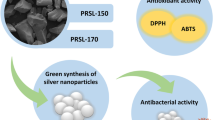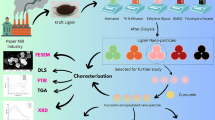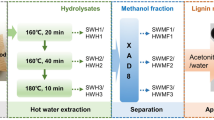Abstract
Zinc oxide nanoparticles (ZnO NPs) have gained a lot of attention with the advent of nanotechnology because of their unique features. The environmentally friendly synthesis of ZnO NPs from lignin would encourage the use of lignin generated as a challenging by-product mainly in paper and biofuel industries. The current study is about the production and characterization of ZnO nanoparticles using lignin. The synthesis was carried out with zinc acetate as a precursor in the addition of lignin at a high pH. X-Ray Diffraction (XRD), Fourier Transform Infrared Spectroscopy (FTIR), Field Emission Scanning Electron Microscopy (FESEM), and High-Resolution Transmission Electron Microscopy (HRTEM) techniques were used to analyze all of the generated lignin-based ZnO nanoparticles. The phase purity of the produced nanoparticles was disclosed by X-ray diffraction, which revealed their crystalline nature with a hexagonal wurtzite structure. The functional groups of lignin successfully attached to the ZnO NPs surface, enabling particle stability, according to FTIR analysis. The morphology and average size (25–50 nm) of the produced nanoparticles were disclosed by FESEM and HRTEM investigations. Positive findings were obtained when the antifungal effectiveness of these particles was evaluated against plant pathogenic fungus Fusarium oxysporum causing basal rot, Fusarium wilt and Fusarium proliferatum causing dry rot diseases in commercially important crops like garlic, onion, maize, tomato, wheat, beans, and cotton. Furthermore, this one-step, cost-effective, and environmentally friendly lignin-derived zinc oxide nanoparticle synthesis process would aid in the manufacturing of many value-added materials in the future.







Similar content being viewed by others
Data Availability
Not applicable.
References
Li, Y., Yang, D., Li, P., & Li, Z. (2022). Lignin as a multi-functional agent for the synthesis of Ag nanoparticles and its application in antibacterial coatings. Journal of Materials Research and Technology, 17, 3211–3220.
Becker, J., & Wittmann, C. (2019). A field of dreams: Lignin valorization into chemicals, materials, fuels, and health-care products. Biotechnology Advances, 37(6), 107360. https://doi.org/10.1016/j.biotechadv.2019.02.016
Schneider, W. D. H., Fontana, R. C., Baudel, H. C., Siqueira, F. G., Rencoret, J., Gutiérrez, A., Eugenio, L. I., Prieto, A., Martínez, M. J., Martínez, A. T., Dillon, A. J. P., & Camassola, M. (2020). Lignin degradation and detoxification of eucalyptus wastes by on-site manufacturing fungal enzymes to enhance second-generation ethanol yield. Applied Energy, 262, 114493. https://doi.org/10.1016/j.apenergy.2020.114493
Schneider, W. D. H., Dillon, A. J. P., & Camassola, M. (2021). Lignin nanoparticles enter the scene: A promising versatile green tool for multiple applications. Biotechnology Advances, 47, 107685. https://doi.org/10.1016/j.biotechadv.2020.107685
Kaur, R., Bhardwaj, S. K., Chandna, S., Kim, K. H., & Bhaumik, J. (2021). Lignin-based metal oxide nanocomposites for UV protection applications: A review. Journal of Cleaner Production, 317, 128300. https://doi.org/10.1016/j.jclepro.2021.128300
Yang, W., Fortunati, E., Gao, D., Balestra, G. M., Giovanale, G., He, X., Torre, L., Kenny, J. M., & Puglia, D. (2018). Valorization of acid isolated high yield lignin nanoparticles as innovative antioxidant/antimicrobial organic materials. ACS Sustainable Chemistry & Engineering, 6, 3502–3514. https://doi.org/10.1021/acssuschemeng.7b03782
Saratale, R. G., Saratale, R. D., Ghodake, G., Cho, S. K., Kadam, A., Kumar, G., Jeon, B. H., Pant, D., Bhatnagar, A., & Shin, H. S. (2019). Wheat straw extracted lignin in silver nanoparticles synthesis: Expanding its prophecy towards antineoplastic potency and hydrogen peroxide sensing ability. International Journal of Biological Macromolecules, 1(128), 391–400. https://doi.org/10.1016/j.ijbiomac.2019.01.120
Koch, D., Paul, M., Beisl, S., Friedl, A., & Mihalyi, B. (2020). Life cycle assessment of a lignin nanoparticle biorefinery: Decision support for its process development. Journal of Cleaner Production, 245, 118760. https://doi.org/10.1016/j.jclepro.2019.118760
Lievonen, M., Valle-Delgado, J. J., Mattinen, M. L., Hult, E. L., Lintinen, K., Kostiainen, M. A., Paananen, A., Szilvay, G. R., Setäla, H., & Osterberg, M. (2016). A simple process for lignin nanoparticle preparation. Green Chemistry, 18, 1416. https://doi.org/10.1039/C5GC01436K
Tarasov, D., Leitch, M., & Fatehi, P. (2018). Lignin- carbohydrate complexes: Properties, applications, analyses, and methods of extraction: A review. Biotechnology for Biofuels, 11, 269. https://doi.org/10.1186/s13068-018-1262-1
Liu, Z. H., Hao, N., Shinde, S., Olson, M. L., Bhagia, S., Dunlap, J. R., Kao, K. C., Kang, X., Ragauskas, A. J., & Yuan, J. (2019). Codesign of combinatorial organosolv pretreatment (COP) and lignin nanoparticles (LNPs) in biorefineries. ACS Sustainable Chemistry & Engineering, 7, 2634–2647. https://doi.org/10.1021/acssuschemeng.8b05715
Del Buono, D., Luzi, F., Tolisano, C., Puglia, D., & Di Michele, A. (2022). Synthesis of a lignin/zinc oxide hybrid nanoparticles system and its application by nano-priming in maize. Nanomaterials, 12, 568. https://doi.org/10.3390/nano12030568
Pineda-Reyes, A. M., & Olvera, M. D. L. L. (2018). Synthesis of ZnO nanoparticles from water-in-oil (w/o) microemulsions. Materials Chemistry and Physics, 203, 141–147.
Klapiszewska, I., Parus, A., Ławniczak, Ł, Jesionowski, T., Klapiszewski, Ł, & Slosarczyk, A. (2021). Production of antibacterial cement composites containing ZnO/lignin and ZnO–SiO2/lignin hybrid admixtures. Cement and Concrete Composites, 124, 104250.
Kumar, S., Nehra, M., Dilbaghi, N., Marrazza, G., Hassan, A. A., & Kim, K. H. (2019). Nano-based smart pesticide formulations: Emerging opportunities for agriculture. Journal of Controlled Release, 294, 131–153.
Sun, L., Wang, Y., Wang, R., Wang, R., Zhang, P., Ju, Q., & Xu, J. (2020). Physiological, transcriptomic, and metabolomic analyses reveal zinc oxide nanoparticles modulate plant growth in tomato. Environmental Science. Nano, 7, 3587–3604.
Joshi, K., Sethi, Y. A., Samb, J., Yogesh, A., Ambalkar, H., Sonawane, S., Rasale, R., Panmand, R., Patil, B., & Manohar, C. (2019). Lignin-mediated biosynthesis of ZnO and TiO2 nanocomposites for enhanced antimicrobial activity. Journal of Composites Science, 3, 90.
Jose, L. M., Kuriakose, S., & Thomas, S. (2020). Fabrication, characterization and in-vitro antifungal property evaluation of biocompatible lignin- stabilized zinc oxide nanoparticles against selected pathogenic fungal strains. BioNanoScience, 10, 583–596.
Watkins, D., Nuruddin, M., Hosur, M., Tcherbi-Narteh, A., & Jeelani, S. (2015). Extraction and characterization of lignin from different biomass resources. Journal of Materials Research and Technology, 4(1), 26–32.
Gunawan, R., & Nandiyanto, A. B. D. (2021). How to read and interpret 1H-NMR and 13C-NMR spectrums. Indonesian Journal of Science and Technology, 6(2), 267–298.
Yedurkar, S., Maurya, C., & Mahanwar, P. (2016). Biosynthesis of zinc oxide nanoparticles using Ixora coccinea leaf extract—A green approach. Open Journal of Synthesis Theory and Applications, 5, 1–14. https://doi.org/10.1021/acssuschemeng.8b02234
Gupta, A. K., & Nayak, S. K. (2014). Synthesis, characterization and application of lignin nanoparticles (LNPs). Materials Focus, 3, 444–454.
Gadhamgahi, F., Atash, M. M. S., & Bonjar, G. S. (2014). Comparison of inhibitory effects of silver and zinc oxide nanoparticles on the growth of plant pathogenic bacteria. International Journal of Advanced Biological and Biomedical Research, 2(4), 1163–1167.
Gutierrez-Hernandez, J., Escalante, A., Murillo-Vazquez, R. N., Delgado, E., Gonzalez, F. J., & Toriz, G. (2016). Use of Agave tequilana-lignin and zinc oxide nanoparticles for skin photoprotection. Journals of Photochemistry and Photobiology, B: Biology, 163, 156–161.
Griggs, B. F. (1985). Modification of kraft lignins by sulfomethylation and oxidative sulfonation: Structure and mechanisms. Ph.D. Thesis, North Carolina State University, 1985.
Nimz, H. H., Robert, D., Faix, O., & Nemr, M. (1981). Carbon-13 NMR spectra of lignins. 8. Structural differences between lignins of hardwoods, softwoods, grasses and compression wood. Holzforschung, 35, 16–26.
Hise, R. G., Chen, C. L., & Gratzl, J. S. (1985). Synthesis of betaaryl lignin model compounds. J. Wood. Chem. and Technol., 5, 379–390.
Nimz, H. H. (1966). Oligomere Abbauphenole des Fichtenlignins. Chemische Berichte, 99, 2638–2651.
Kaur, R., Thakur, N. S., Chandna, S., & Bhaumik, J. (2020). Development of agri-biomass based lignin derived zinc oxide nanocomposites as promising UV protectant-cum-antimicrobial agents. Journals of Materials Chemistry B, 8, 260–269.
Jiang, J., Pi, J., & Cai, J. (2018). The advancing of zinc oxide nanoparticles for biomedical applications. Bioinorganic Chemistry and Applications. https://doi.org/10.1155/2018/1062562
Mahamuni, P. P., Patil, P. M., Dhanavade, M. J., Badiger, M. V., Shadija, P. G., Lokhande, A. C., & Bohara, R. A. (2019). Synthesis and characterization of zinc oxide nanoparticles by using polyol chemistry for their antimicrobial and antibiofilm activity. Biochemistry and Biophysics Reports, 17, 71–80.
Kulkarni, S. S., & Shirsat, M. D. (2015). Optical and structural properties of zinc oxide nanoparticles. International Journal of Advanced Research in Physical Science, 2(1), 14–18.
Kalia, A., Kaur, J., Tondey, M., Manchanda, P., Bindra, P., Alghuthaymi, M. A., Shami, A., & Abd-Alsalam, K. A. (2021). Differential antimycotic and antioxidant potentials of chemically synthesized zinc- based nanoparticles derived from different reducing/complexing agents against pathogenic fungi of maize crop. Journal of Fungi, 2, 223.
Barzinjy, A. A., & Azeez, H. H. (2020). Green synthesis and characterization of zinc oxide nanoparticles using Eucalyptus globulus Labill. Leaf extract and zinc nitrate hexahydrate salt. S N Applied Sciences, 2, 991.
Agarwal, H., Kumar, S. V., & Rajeshkumar, S. (2017). A review on green synthesis of zinc oxide nanoparticles—An eco-friendly approach. Resource-Efficient Technologies, 3, 406–413.
Muhammad, W., Ullah, N., Haroon, M., & Abbasi, B. H. (2019). Optical, morphoogical and biological analysis of zinc oxide nanoparticles (ZnO NPs) using Papaver sominiferum L. RSC Advances, 9, 29541–29548.
Chaudhary, A., Kumar, N., Kumar, R., & Salar, R. K. (2018). Antimicrobial activity of zinc oxide nanoparticles synthesized from Aloe vera peel extract. SN Applied Science, 1, 136.
Yehia, R. S., Ahmed, O. F. (2013). In vitro study of antifungal efficacy of zinc oxide nanoparticles against Fusraium oxysporum and Penicilium expansum. African Journal of Microbiology Research 7(9): 1917–23. http://www.academicjournals.org/AJMR.
Mondani, L., Chiusa, G., & Battilani, P. (2020). Fungi associated with garlic during cropping season, with forcus on Fusarium proliferatum and F. oxysporum. Plant Health Progress, 22, 37–46. https://doi.org/10.1094/PHP-06-20-0054-RS
Acknowledgements
The XRD and NMR analysis was done by IIT Ropar, and FTIR, FESEM, and HRTEM were employed by SAIF laboratory, Punjab University, Chandigarh. Authors are grateful for their work towards current research.
Funding
No funding was received for conducting this study.
Author information
Authors and Affiliations
Contributions
PS performed the research provided in the article and wrote the manuscript, whereas NS supervised the research work and reviewed the manuscript.
Corresponding author
Ethics declarations
Ethics Approval and Consent to Participate
Not applicable.
Consent for Publication
Not applicable.
Competing Interests
The authors have no competing interests to declare that are relevant to the content of this article.
Research Involving Humans and Animals Statement
This research does not contain any human or animal involvement. The techniques were performed in different institutions with proper procedures involved for fee payment and their help has been acknowledged.
Additional information
Publisher's Note
Springer Nature remains neutral with regard to jurisdictional claims in published maps and institutional affiliations.
Rights and permissions
Springer Nature or its licensor (e.g. a society or other partner) holds exclusive rights to this article under a publishing agreement with the author(s) or other rightsholder(s); author self-archiving of the accepted manuscript version of this article is solely governed by the terms of such publishing agreement and applicable law.
About this article
Cite this article
Sharma, P., Sharma, N. Lignin Derived from Forestry Biomass as Capping Reagent in the Biosynthesis and Characterization of Zinc Oxide Nanoparticles and Their In Vitro Efficacy as a Strong Antifungal Biocontrolling Agent for Commercial Crops. BioNanoSci. 13, 36–48 (2023). https://doi.org/10.1007/s12668-022-01052-3
Accepted:
Published:
Issue Date:
DOI: https://doi.org/10.1007/s12668-022-01052-3




